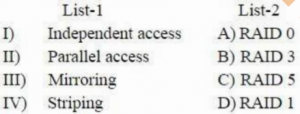RAID
Question 1 |
Raid configurations of the disks are used to provide
Fault-tolerance | |
High speed | |
High data density | |
None of the above |
Question 1 Explanation:
Raid is a way of storing the same data in different places on multiple hard disks to protect data in the case of drive failure.
So, we can say that RAID is used to provide fault tolerance.
So, we can say that RAID is used to provide fault tolerance.
Question 2 |
Match the following.

I-B,II-C,III-D,IV-A | |
I-C,II-B,III-D,IV-A | |
I-A,II-D,III-B,IV-C | |
I-B,II-A,III-D,IV-C |
Question 2 Explanation:
The standard RAID levels comprise a basic set of RAID (redundant array of independent disks) configurations that employ the techniques of striping, mirroring, or parity to create large reliable data stores from multiple general-purpose computer hard disk drives (HDDs). The most common types are RAID 0 (striping), RAID 1 (mirroring) and its variants, RAID 5 (distributed parity), and RAID 6 (dual parity).
RAID levels and their associated data formats are standardized by the Storage Networking Industry Association (SNIA) in the Common RAID Disk Drive Format (DDF) standard
RAID levels and their associated data formats are standardized by the Storage Networking Industry Association (SNIA) in the Common RAID Disk Drive Format (DDF) standard
Question 3 |
Match the LIST-I with LIST-II
|
LIST-I |
LIST-II |
||
|
A |
RAID level 1 |
I |
bit-interleaved parity organization |
|
B |
RAID level 2 |
II |
disk mirroring |
|
C |
RAID level 3 |
III |
block-interleaved parity organization |
|
D |
RAID level 4 |
IV |
ECC organization |
Choose the correct answer from the options given below:
A-II, B-I, C-IV, D-III
| |
A-II, B-IV, C-I, D-III | |
A-III, B-IV, C-I, D-II | |
A-IV, B-III, C-II, D-I |
There are 3 questions to complete.
